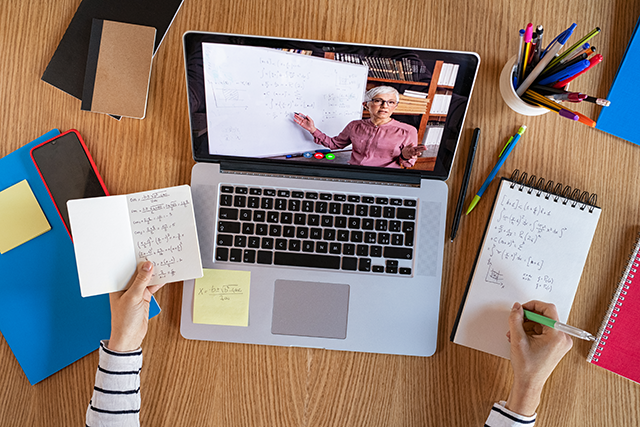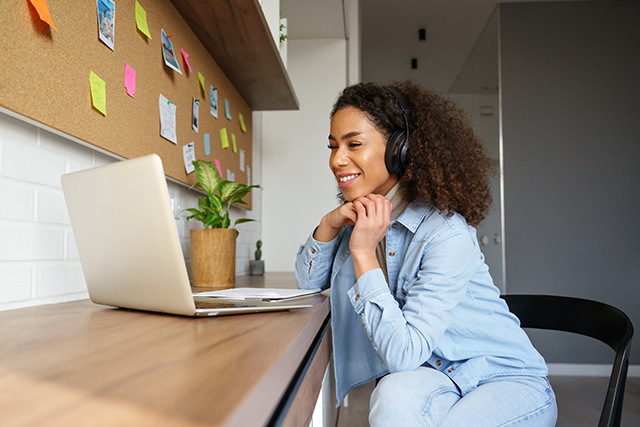The world has changed in the past few weeks and our work lives have changed too.
For many professionals, this means setting up an at-home workspace and establishing a new routine. But shifting a school online is a whole other beast.
How can you continue your student’s learning remotely?
With little prep time, many teachers have been thrown in at the deep end of teaching from home, before even covering the basics of how to get started teaching online.
While grappling with a new work set-up, they’re also facing more important questions such as:
- How can I look after my students’ welfare virtually?
- And how do I decide which learning goals to keep and which to toss out?
One thing’s for sure: there’s a lot to get our head around as you adapt to teaching from home.
Luckily, adapting and thinking on your feet are two things teachers have to do every day. And, if you need to do a quick brush up on your skills, there are many online teaching courses for educators to help you.
Here are some things to focus on to get started teaching online from home:
- Get used to the new technology
- Adapt your materials
- Set new learning goals
- Get in the right mindset
- Boost your skills
Get used to the new technology.
Making the switch to teaching from home can mean quickly learning how to manage video calls, online chats, making videos, virtual homework and remote admin.
If you haven’t worked with video conferencing tools before, that’s a lot of re-skilling to do in a short amount of time. So, start with the essentials.
First, spend a few minutes every day making sure you feel comfortable and confident using the technology that you have to use.
Then you can branch out into all the different teaching from home technology out there. There are endless games, quizzes and other resources. Want to make a class website? Create videos? Record a song together? It’s all possible online.
And don’t forget you have a great resource to ask about all the latest technology to use: your students.
When it comes to the main types of technology that will keep you in direct contact with your online students here are a few pointers:
Video calls
- Make sure you have a neutral background and your face is lit from the front.
- Put some virtual classroom management strategies in place, especially for turn-taking and listening.
- Remember, time can go more slowly than normal in video calls. Plan short activities to keep the pace up.
Online chat
- Encourage students to check in with you and if they don’t, reach out to them regularly.
- Accept the questions your students ask, even if they seem obvious. This an opportunity for social connection, as much as for you to give learning support and advice.
- Find out who to direct students to if they have questions you can’t help with, such as IT support and health advisors.
Lastly, don’t forget to keep in touch with parents, guardians and caregivers too! Strategies that you would typically use to stay in touch with these groups might be disrupted, but you can still communicate via email.

Adapting your materials.
Now that you know how to deliver your lessons, it’s time to think about the teaching materials you’ll be using while you teach from home.
You can, of course, spend hours making new tech-friendly materials. But why not think about how you can adapt the materials you already have?
Firstly, not all the activities you plan have to be virtual.
Your students’ daily screen time has probably gone up drastically in any case. So, you can still ask students to write in their workbooks or make art, as you would in your regular classroom. Ask them to send you pictures of what they’ve done.
If you’re studying together online, virtual writing groups or math clubs (where students work individually but in a shared virtual space) can also work as on-paper activities.
However, going digital does offer some great opportunities for new activities. So, think about how you could adapt normal tasks to make them digital-friendly.
Could your students make presentation videos to show each other for homework? Or create a website together? Or write online quizzes for each other?
Set new learning goals
As an online teacher, you set the tone for your digital classroom. You know when to settle students down for quiet work. Or introduce some movement to lift the mood. Or reward them with fun, noisy games.
Truth is online education can feel a little flat to your students.
Without the in-person group dynamic, it might be harder for you and your learners to stay focused on course materials. And it’s much harder for you to monitor and track the progress your students are making when they’re not right in front of you.
There are plenty of strategies you can use to increase engagement in your online classroom.
But it might also be time to rethink your learning goals.
All of your students are studying in different circumstances. Many may be dealing with high levels of stress and uncertainty. Some will be able to focus on their studies, and some won’t.
It might be that connected relationships and wellbeing become the focus of your learning goals at this time.
Or that you shift focus onto how learning at home can be self-directed.
Because even if the school curriculum is disrupted, your students will still be learning all the time. Now is a moment to be accepting and make your classroom an inclusive place for all.
Make the mental switch.
As a consistent adult presence, you are an essential source of stability, motivation and encouragement for your students. That’s true every day – but especially at a time when the world seems like a scarier place than usual.
Taking a trauma-informed approach to teaching through coronavirus means putting your students and your own wellbeing first.
Simple things like establishing a routine and staying connected will be hugely reassuring for your students.
So, make sure you are in a position to provide the best support you can by looking after yourself and your own mental health. This might mean an elaborate self-care routine or simply watching more Netflix.
But it might also mean that before you start work, you need to make the mental switch, the same way you might before stepping into the classroom each morning.
Before starting a video call or online chat with your students, give yourself 15 minutes to get in the zone.
Avoid getting caught in a rabbit hole by scrolling through the news or social media. Make sure you’re not hungry or thirsty. Either destress or get your energy up. And focus on the learning experience you want to manifest in your online class.
Another way to look after yourself is by changing your teaching mindset to meet this moment.
Otherwise known as giving yourself a break.

Boost your skills.
Teaching from home is a different skill to teaching in the classroom. And it’ll take time to get right.
For the past few months, teachers around the world have been learning on the fly, in challenging circumstances.
So, don’t beat yourself up if you feel like you’re not nailing it right away. And don’t forget there is support out there for you.
Taking an online teaching course for educators can help boost your teaching from home skills quickly.
Or you could focus on one skill at a time. Try one new activity in the virtual classroom, or one new piece of technology you want to master.
And don’t forget the old-school style of skill-sharing either: the staffroom. Keep in touch with your colleagues online to share your successes and failures.
You might just be getting started teaching online now but in a few weeks, you’ll feel much more confident.
And while the challenges teachers are facing now will come to an end, the skills you are learning in these unusual conditions will last for the rest of your career.
Don’t forget: you’re a great teacher!
Teaching at home is different from teaching face to face, and it’ll take a minute to feel confident in your new online environment.
Sure, you might need to brush up on a few technical skills for your online classroom. But this doesn’t make you any less of a great teacher.
You already know how to support your learners and how to bring out the best in them.
And the essential skills you need to be a great teacher are the same, whatever the context.
Again, to make your online learning environment great for you and your students. You’ll need to:
- Get used to the new technology
- Adapt your materials
- Set new learning goals
- Get in the right mindset
- Boost your skills
Fundamentally, it’s your core teaching skills that can really help your students (and your whole school community) right now.
So remember, you’re a great teacher already. And in the strangest of circumstances, you’re probably still doing a great job. Keep going!



